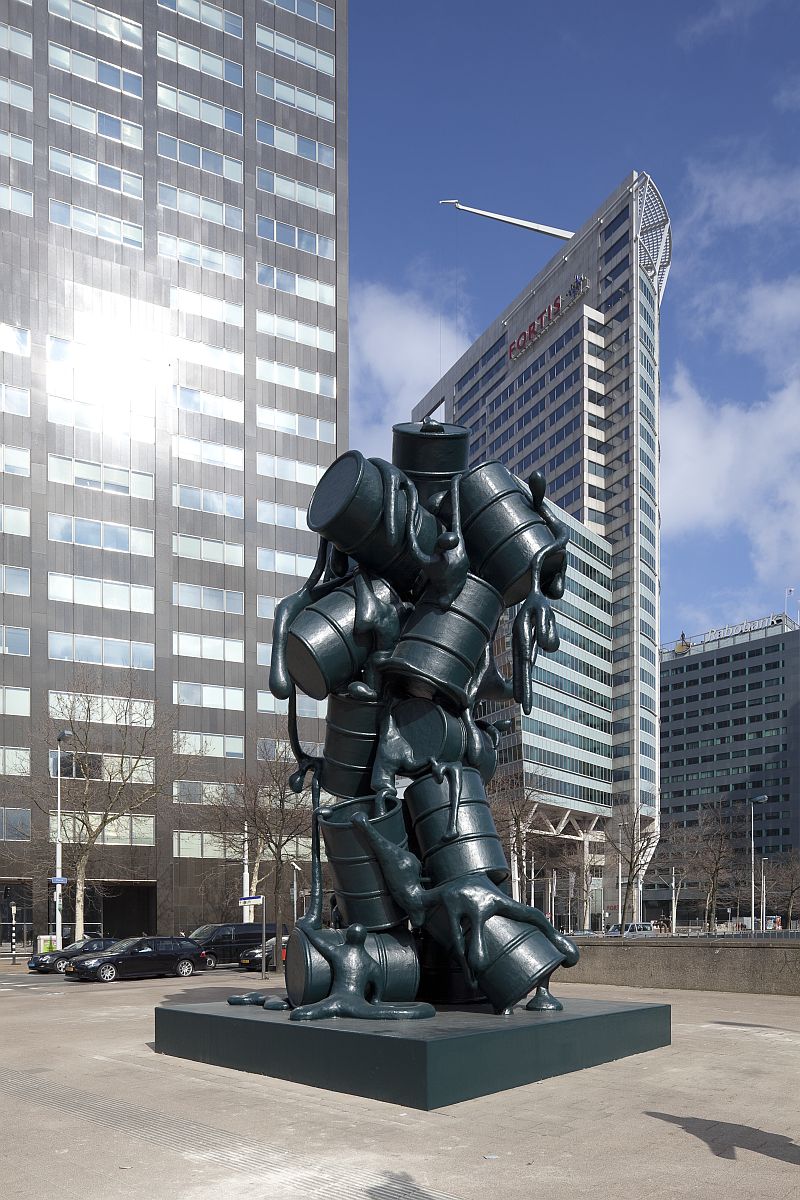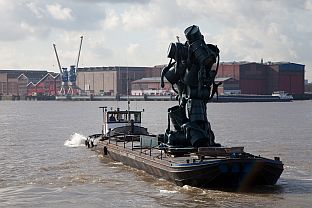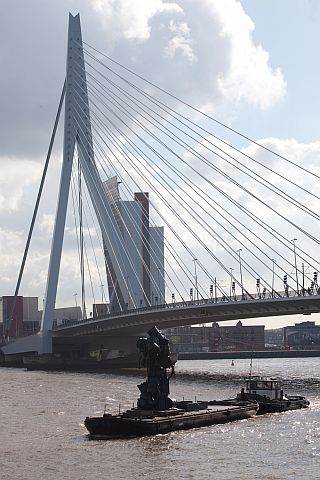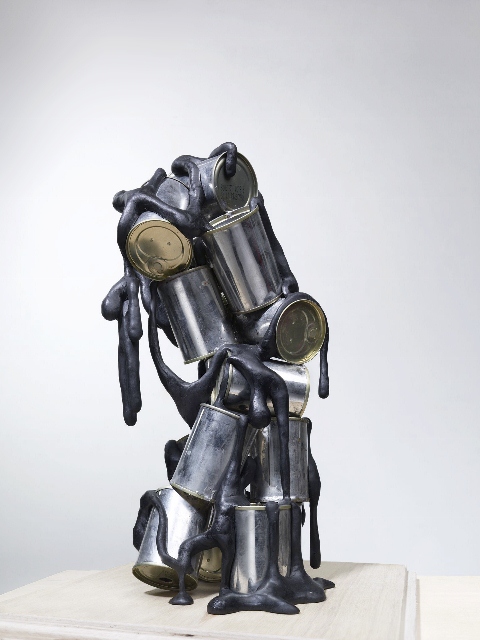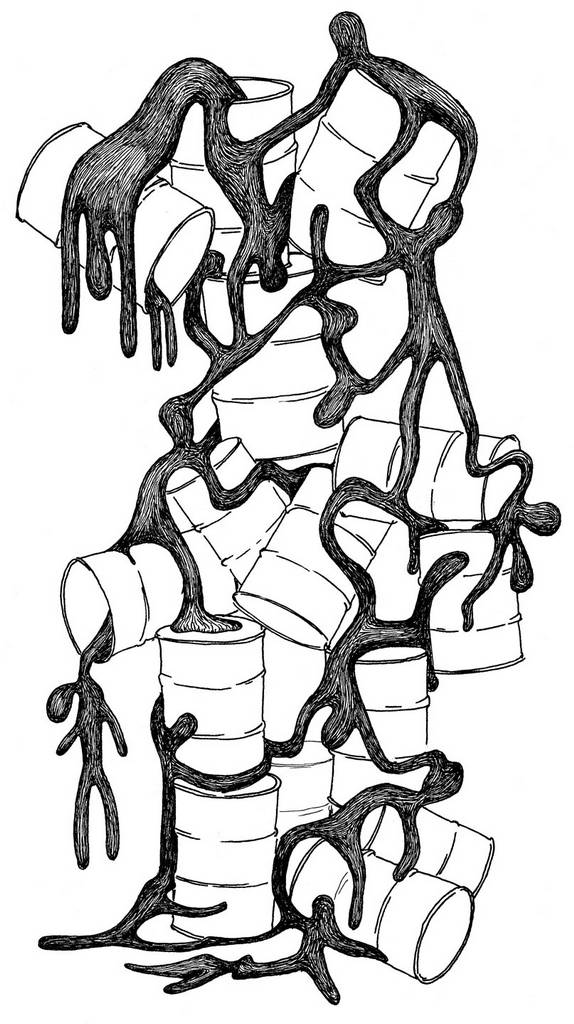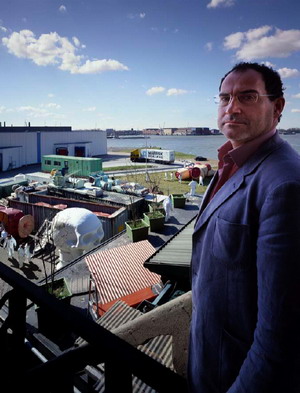Cascade
And there stands the sculpture by Atelier Van Lieshout: a dark green tower of oil drums, photographed at dusk and surrounded by the economic heart of the city. This sombre photo was the opening slide of a symposium by the Economic Development Board Rotterdam in autumn 2011, about the utility of beauty in the city. A club of men sat around tables, brainstorming about ways to draw international business to the port city. They concluded that a cultural image makes it a more attractive place to establish a business, and recommended touting the raw beauty of the city. In the background shone the projection of Cascade, a work of art that criticises as well as affirms the capitalist element of business.
Two years earlier, SIR had asked Van Lieshout to develop a proposal for the heart of the city. This choice was almost a foregone conclusion. Rotterdam has an international sculpture collection, but at that time it still had nothing by the most famous contemporary Rotterdam sculptor. Furthermore, SIR gave the artist carte blanche to pick a location in the city centre. Van Lieshout chose Churchillplein, the only square without a sculpture along Coolsingel, a street scheduled for transformation into an alluring urban boulevard over the coming years. At present, its main characteristic is being a rather odd place: a main traffic route without an identifiable beginning or end, where roads intersect and the proximity of the River Maas is hidden by tall buildings. A monumental sculpture such as Cascade would be a foretaste of its future grandeur. For now, the main thing was that it should tower up to compete in this environment – gleaming office blocks that project the riches of the business world, the skyline of the dreamed-of metropolis. It was entrusted to Van Lieshout to provide this competition.
The official interpretation of the Van Lieshout sculpture, by the artist himself, concerns that business world: a rickety pile of oil drums as the unstable representation of a collapsing economy. It is a work of art in the classic modern sense of presenting us with a mirror: ecce homo; the world is tottering. From the oil drums hang melancholy figures that attempt to climb this symbolic ladder; some of them falling, others trampled down by fiercer career hunters. Those who wish may read even more into it, noting that none of these homunculi realise that they are made of oil and hence (from a quasi-Marxist standpoint) a raw material in the economic production of big capitalism. Van Lieshout is not one to beat about the bush. In his dystopian Slave City, employees are ground into foodstuff when they don’t perform well.
But above all, it is a real Rotterdam scenario with its oil drums being imported, as it were, into the harbour. That is where Van Lieshout has his studio. If you take a tour with the Spido water bus, you will pass (among all the containers) a strange place of polyester skulls and human figures. In this ‘AVL-Ville’, Van Lieshout lobbied in the nineties for a Free State. That didn’t take off: the Dutch laws made no exception for Atelier Van Lieshout. Despite that, his rebellion bore fruit. It contributed to the formation of a myth – wild parties, spit-roasted pigs, dubious working conditions, and weapons – that continues to propagate. The hullaballoo spread across national borders. Van Lieshout was invited to attend major international art demonstrations. From being anti-authoritarian, he became an authority himself, with his greatest triumph so far the development of the décor for Wagner’s operas in Bayreuth.
And that is what Cascade is mainly about: the self-made cultural entrepreneur Joep van Lieshout. On seeing this sculpture, one recognises the oil industry, but primarily one recognises Van Lieshout. This is because of his recognisable visual language. In his business he has developed a style of anonymous human figures that he executes in the same material – polyester – as his caravans and furniture. As such, his stylised human figures are so typically ‘Van Lieshout’ that each sculpture serves, in a certain sense, as a logo for his business. They have the style that has become definitive in the visual world since the advent of modern art, even though the dripping form of Cascade has a rather different silhouette. Like his other sculptures, however, this one is also extremely photogenic thanks to its simplicity. This is something he has in common with other international art stars – Koons, Hirst and Prince – who use art market mechanisms for their own ends.
Despite international fame, Van Lieshout has intimately connected his image and the course of his life to the port city of Rotterdam. At the end of the last century, he already appeared to be a symbol of this robust city that lagged at the bottom of the good lists and stood at the top of the bad ones. When the furniture manufacturer Lensvelt asked him to design a suite of office furniture, they decided to expand on his rugged image. The cover of the catalogue, filled with desks and chairs, displays the artist as a freedom fighter, chest half bared, on an armed wagon from his ‘Free State’ years that was purchased by Museum Boijmans Van Beuningen. This triumphal chariot and museum piece is a unique selling point that no other furniture manufacturer can emulate.
The metamorphosis from rebellious artist to career maker is going down well with public opinion. In Design and Crime, Hal Foster analyses how Frank Gehry was able to move from his rebellious background to success as a designer of logo architecture, precisely because he was seen as an anarchist. Impious images with an impious past count as doubly daring. The same applies to Van Lieshout. He also creates logo images that are larger than life and immediately understandable – as striking as Gehry’s iconic buildings. With this simplicity he competes with the corporate styles of the surrounding commerciality.
This kind of coming-of-age story is a sign of personal development and, given the idiosyncrasy of the arts, a definite victory in these barren times of individualism. In that sense, Cascade, with its wrestling homunculi, is a self-portrait. Van Lieshout’s success arises from a desire to blossom and rise above the mass, above the anonymous figures that climb up his Cascade. These are the worker ants that fill the world but with which nobody wants to identify. The global economy has such a drastic effect that people lose their grip on their world and their work. They feel tossed around like playthings; in Marxists terms, they are tiny cogs in society. You can see that in the little figures of Cascade. They are faceless figures that strive to survive in a threatening economy. Van Lieshout wins that battle.
It is this bravura and iconic strength that the men of the Economic Development Board Rotterdam support. The projected slide of the Cascade could not have been better chosen. The style of this immediately comprehensible sculpture fits in with the world of business, what it relates to and what it magnifies. The smooth finish and the businesslike Atelier Van Lieshout signature symbolise an entirely different kind of art than that of the lonely artist in his garret. Atelier Van Lieshout is itself big business. It wants to unmask überkapitalismus via that very same capitalism: a large work of art is exclusive, an element of the art market. This victory column does not only commemorate the world of business; it is also a monument to Joep van Lieshout at an A-class location, an 8-metre high triumphal column on a pedestal.
Sandra Smets
